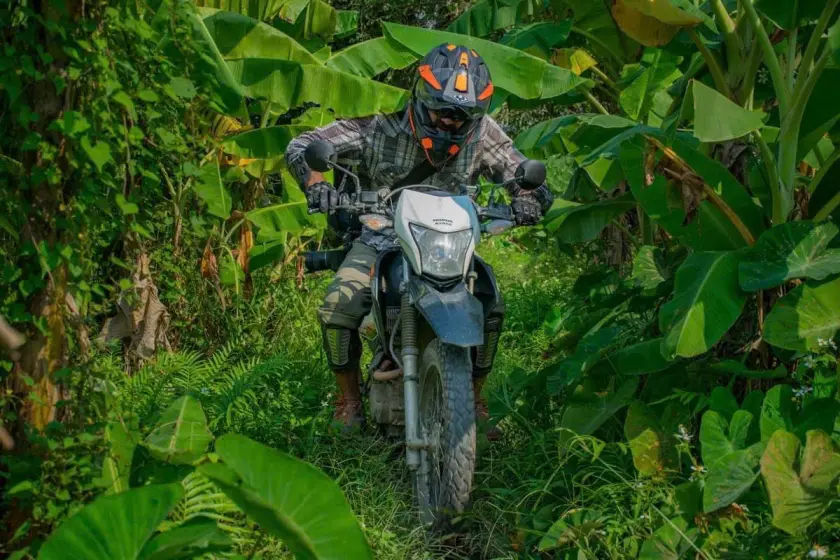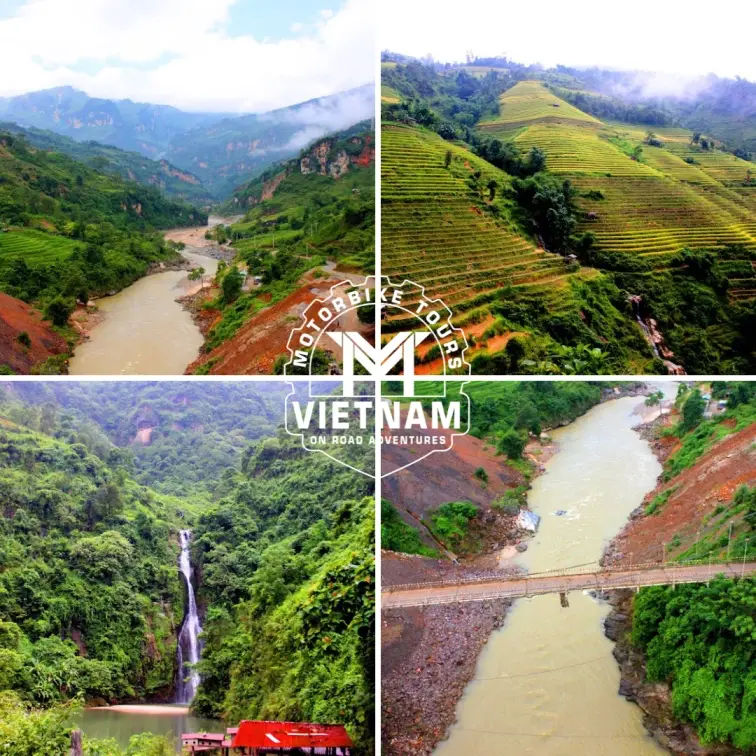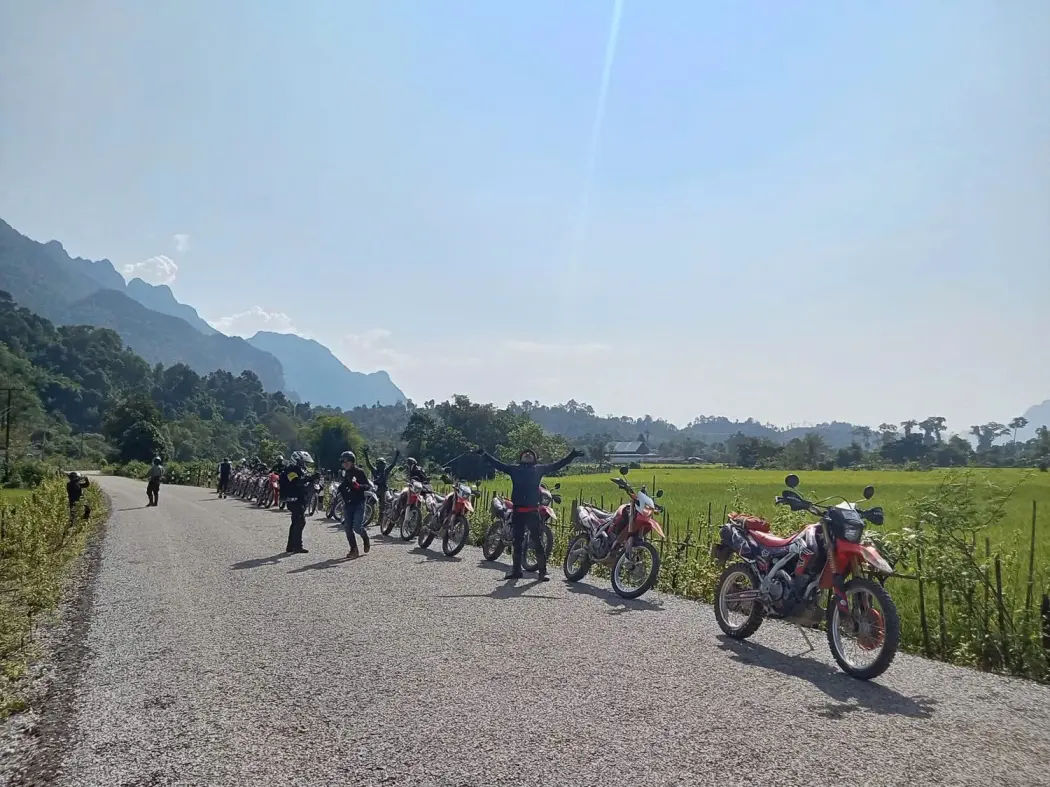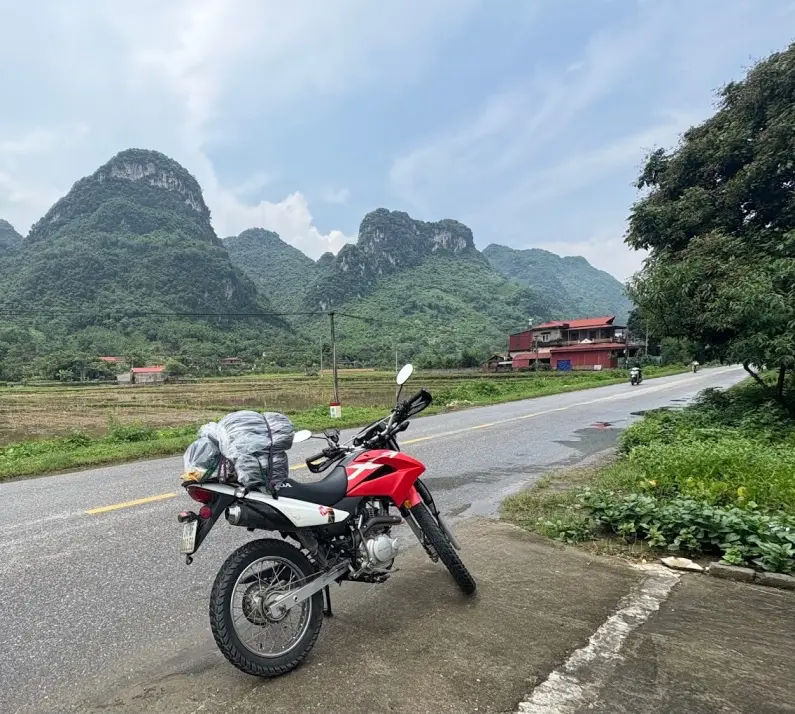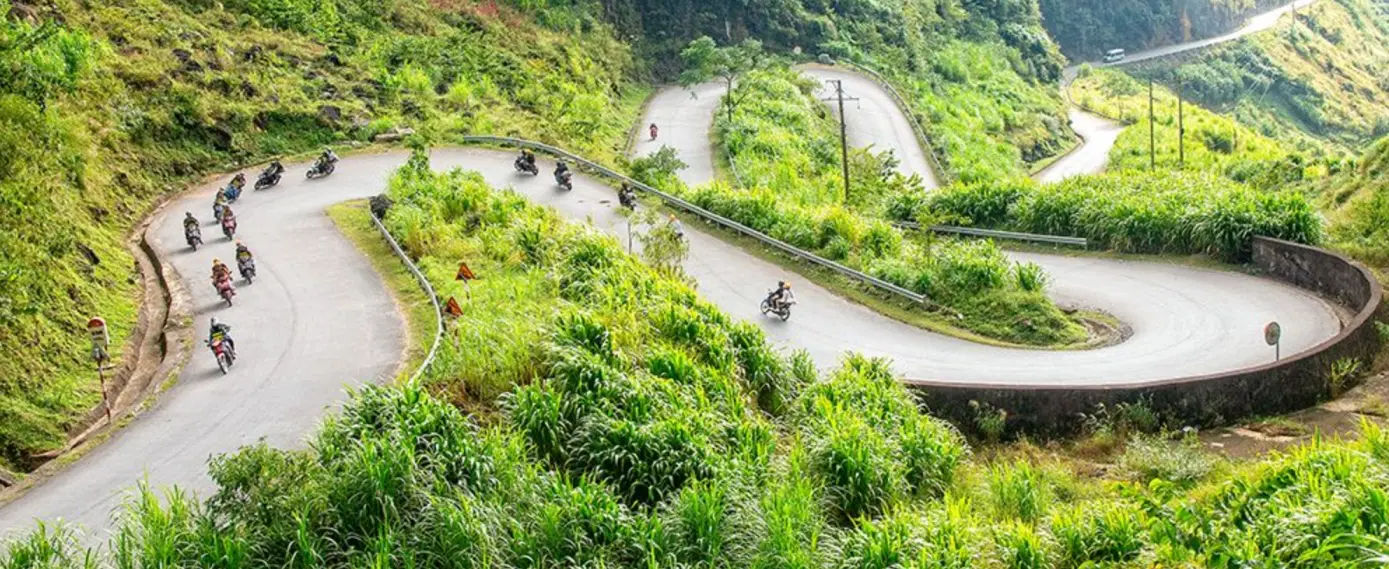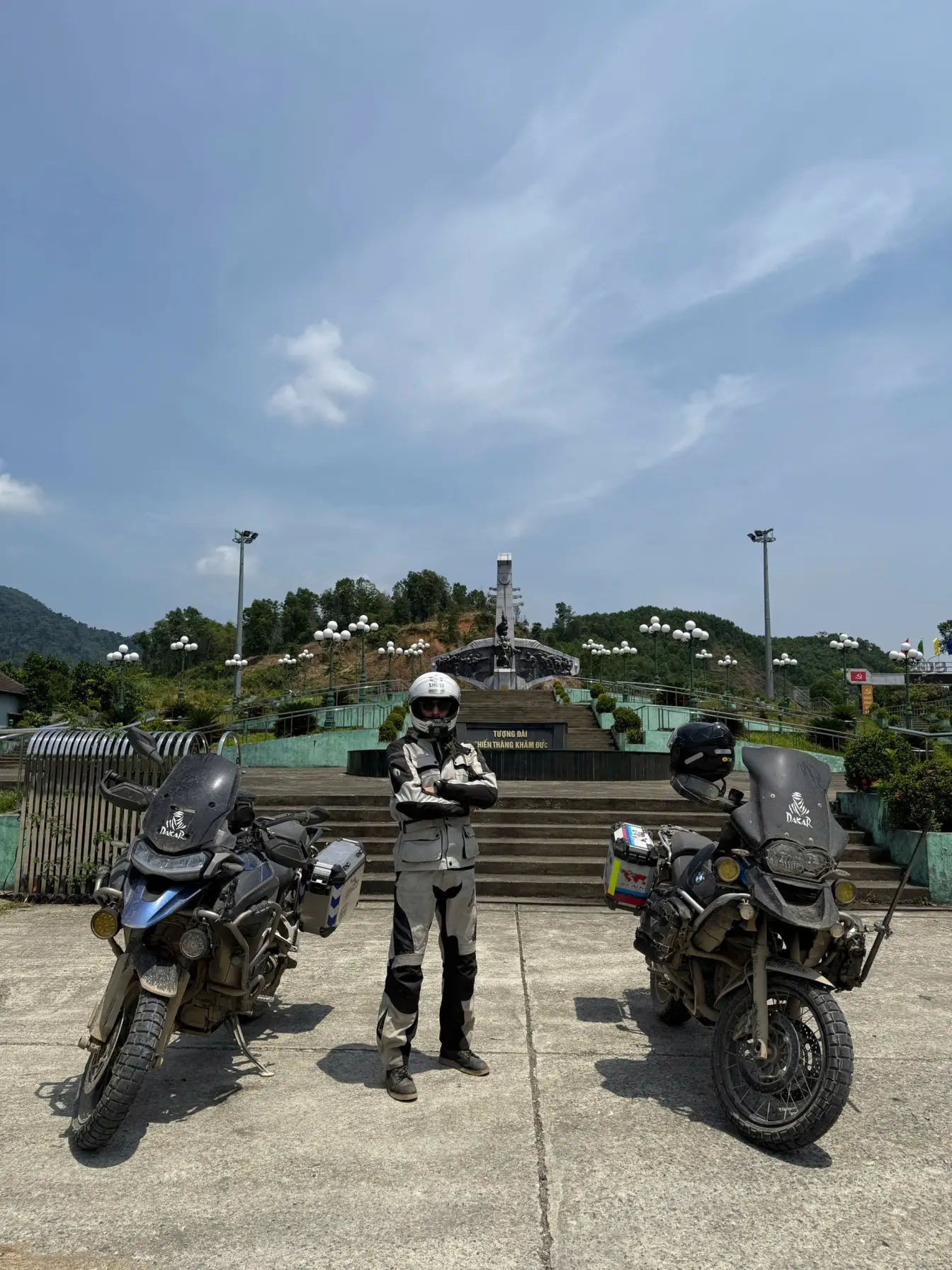
Northern Vietnam offers breathtaking landscapes with amazing rivers, cascading waterfalls, and lush green valleys. Motorbiking along these routes provides adventurers a unique way to explore remote villages, scenic viewpoints, and natural wonders while experiencing the thrill of riding on diverse terrains. In this guide, we’ll cover the best routes, essential motorbikes, and gear needed to make your trip safe and unforgettable.
- Check out Best Vietnam Motorcycle Tours
Motorbiking Along Northern Vietnam Rivers and Waterfalls: Introduction
Hey fellow riders, Hamid here and again, another post im sharing my experience on a post about riding a motorbike ride in northern Vietnam rivers and waterfalls. If you’ve ever sat on a bike, staring at Google Maps, wondering where the next big adventure is, let me take you on a ride I’ll recommend to you as well: northern areas of Vietnam is a place to be, where rivers carve through misty mountains, waterfalls thunder like nature’s drums, and your motorbike becomes your best friend.
Over the past few years, I’ve pieced together routes, gear lists and lessons learned so you can ride smart, safe and enjoy the scenery. Think of this as a totally remarkable and a new experience.
Riding in northern Vietnam brings together three things I love: the freedom of two wheels, wild landscapes that seem unreal, and the sheer unpredictability of the road.
We’re talking big rivers (green, jade, rushing), remote waterfalls (hidden in jungle or along rough tracks), and roads that climb, wind, drop, and surprise. And yes, you’ll get dusty, wet, cold, exhilarated, maybe nervous. But when you crest a pass and see the river 300 m below, or smash through a curve at sunset with the waterfall’s mist in your mirrors, it’s worth it.
In this guide I’ll walk you through the routes, essential gear and safety equipment, and travel tips & best practices you’ll want to know before you hit the road.
Area Map
Top Motorbiking Routes Along Rivers and Waterfalls
One of the most talked-about motorbiking routes in Northern Vietnam runs along the twisting rivers and hidden villages of Ha Giang, Cao Bang, and Lai Chau, a great way for those chasing raw, unfiltered adventure.
I often see riders on Facebook asking, You don’t ride Ha Giang for speed, you ride it for the views that make you stop every ten minutes. My question is which part of the Ha Giang are they talking about? The boring one everyone jump behind the scooter organized by those guest houses or the real one riding through the jaw-dropping terrains that those guest houses never even knows about?
- First thing first, check out Lesser-known routes along the Ha Giang Loop
The route from Ha Giang to Dong Van flanked by the Lo River, offering endless photo stops, while the path to Ban Gioc Waterfall in Cao Bang is praised for its emerald rivers cutting through karst valleys.
On travel forums (im the member as well) bikers share how the road from Ba Be Lake to Cao Bang is a secret gem, quiet, scenic, and dotted with local tea houses where you can rest your engine and sip green tea with villagers.
Route 1: Ha Giang Loop and Surrounding Rivers
If I had to pick the route to kick off your northern experience include some ride along the river/waterfall, it’d be the road less taken along the Xin Man following the road DT178. This is where you ride high, wild, and you ride with a river (or two) whispering below you and waterfalls sneaking into your photo frames.
Key viewpoints and must-see waterfalls
- DT178 (Xin Man – Hoang Su Phi Route):This lesser-known route is a hidden masterpiece for riders seeking Vietnam’s raw, natural beauty. Winding through the misty Chay River valley, terraced rice fields, and sleepy mountain villages, DT178 delivers that perfect mix of challenge and serenity.
- The stunning valley of the Nho Que River beneath the towering cliffs of the Ma Pi Leng Pass gives you that “I can’t believe I’m here” moment.
- While the Ha Giang is more famed for rugged mountain passes than massive waterfalls, riders still find small cascades and jungle-fringed streams just off the main track.
- The viewpoint called Heaven’s Gate (Đèo Cổng Trời in Vietnamese) near Quan Ba offers sweeping views into the river valleys below, a must-stop for every rider. Bonus: follow the road downstream to the tranquil waters around Du Già, where local homestays hide secret swimming spots and peaceful riverside camps.
Road conditions and difficulty level
Let’s be honest — this isn’t a lazy Sunday ride along the city. The roads are mountainous, with winding ribbon corners, steep drops, narrow lanes, and the occasional patch of rough pavement or landslide debris.
According to Duc, our rider / guide, the main loop covers around 384 km, and the recommended duration is 3 to 10 days, depending on your time. Riders on groups describe it as moderately challenging but absolutely worth it for the stunning views, while others note that the Ô Quy Hồ Pass near Sapa though in a neighboring region is among the top four hardest and most dangerous passes in Northwest Vietnam, a warning that applies here too.
Expect medium-to-hard difficulty if you’re on a 150–250cc bike (recommended for beginners), especially if you explore side tracks. Police checks are frequent, so make sure your paperwork is in order. My advice: take your time, don’t rush, check the weather (fog and rain make roads slippery), and ride conservatively when the terrain gets rough but when it opens up, wow.
Route 2: Cao Bang and Ban Gioc Waterfalls
Next up is the northeast frontier ride: the province of Cao Bang, with the highlight being the majestic Ban Gioc Waterfall on the Vietnam–China border.
This route offers riverside riding and a true waterfall spectacle. From Cao Bang to Hà Giang, it’s roughly 300 km (about 7 hours by motorbike), while Cao Bang to Sa Pa stretches about 480 km. From Ha Giang to the Ma Pi Leng Pass, expect around 20–25 km of breathtaking, cliff-hugging mountain road, short in distance but unforgettable in experience.
- Let’s compare: Ha Giang Vs Cao Bang
Scenic spots along the river
- The journey toward Ban Gioc follows the winding paths of the Quây Sơn and other rivers that snake through limestone karsts. These rivers make for epic riding companions.
- On that ride you’ll pass rustic villages, forests, emerald-green waters, and at Ban Gioc the huge drop of the falls into a river basin, it’s a dramatic end-point.
- Many motorbike tours list this destination explicitly.
Recommended stops for photography
- Get to Ban Gioc early morning or late afternoon for the best light.
- Look for vantage points across the river (often from the China-side viewpoint if you cross) for full-frame waterfall + river + bike shot.
- Pause at homestays or river-side lodges for sunrise reflections.
- On the ride in, stop at roadside cafés overlooking river bends they make excellent halfway panoramas before you hit the big waterfall.
- Bring waterproof bags for your camera gear—mist from the waterfall catches you by surprise.
Road conditions & difficulty
Better than some of the more remote side-roads of Ha Giang, but still expect curves, narrow lanes, patchy surface, and less traffic but more remote support. We describes the route from Quang Uyen to Ban Gioc Waterfall for about ~150 km
Also, note that this region is less developed in parts, so fuel stations, mechanics and mobile signal may be spotty. I’d recommend arriving with a full tank and minimal petrol fear.
Route 3: Northern Highlands Hidden Waterfalls
If you’ve tackled the first two routes or want something more off-the-beaten-path, Route 3 is for you, a ride through hidden waterfalls, remote valleys, and quiet, scenic roads where few tourists venture. Think highland tracks, forest shadows, and unadvertised cascades that appear around unexpected bends.
- You may check off-road motorbike tour
My suggestion is: Start from Cao Bang and take QL3 south toward Nguyên Bình, then continue along DT212 or DT211 toward Bảo Lạc for some of the most picturesque stretches, rolling hills, riverside villages, and lush karst formations. From there, head west toward Mèo Vạc or Bắc Mê if you want to loop back into Hà Giang province.
Along this route, riders often mention the charm of Phia Đén and Phia Oắc villages misty highland hamlets surrounded by pine forests and tea plantations, perfect for a coffee stop. Tĩnh Túc is another gem, known for its rugged mountain views and quiet, authentic vibe. If you’re craving more remote adventure, detour toward Khuổi Ky Stone Village near Bản Giốc or Trùng Khánh, where traditional stone houses line the hillside.
Expect winding roads, fewer vehicles, and a sense of true exploration. Route 3 rewards riders who enjoy solitude, scenery, and surprise waterfalls the kind that don’t have a name on Google Maps but stay in your memory long after the ride ends.
Off-the-beaten-path locations
These may be small local waterfalls rather than showpiece giants, but that’s part of the charm, expect tracks that veer off the main roads into forested valleys and end at quiet rivers or hidden falls where few tourists linger; as one forum rider put it, “I did it in 2019 on a Vietnamese motorbike five days sounds impossible with the amount of climbing,” and indeed, remote here means steep and rough.
Tips for accessing remote areas safely
Make sure to download an offline map since the signal can be weak in more remote areas, and always let someone like your hostel or local friends know your route and expected arrival.
Travel light, as heavy luggage slows you down on dirt and rocky trails. As a rider, we advise, carry some food before setting off since the adventure can take time and choose a motorbike with some off-road capability, as smaller scooters may struggle on rugged tracks.
Avoid the monsoon season (June–August) when trails become slippery and landslides are common. Finally, use local knowledge ask villagers about road conditions, river crossings, or recent landslides—they usually know first.
Choosing the Right Motorbike for Northern Vietnam
I almost mention this on all my guides and posts, for Northern Vietnam’s mix of paved roads and rough mountain tracks, an adventure or dual-sport motorbike like a Honda CRF250 or 300, XR150L, or 190L, or a light adventure motorbike like CB500X would be ideal.
These bikes handle bumps, dirt, and steep climbs much better than small scooters. The roads can get uneven and rocky, and on a basic city bike, every bump will feel harsh and tiring. Check out BMW tours in Vietnam
Off-Road vs Semi-Off-Road Motorbikes
When choosing a bike for the northern adventure ride, you’ll often hear about two main types: off-road (adventure) and semi-off-road (dual-sport). After riding through these areas myself, here’s how I see it.
The off-road/adventure bikes like the Honda XR150L or slightly bigger like the 250cc+ dual-sport models come with proper suspension, knobby tires, and high ground clearance. They handle rough tracks, rocky climbs, and remote waterfalls with ease. You really feel the difference when the road turns to dirt or broken stone.
The semi-off-road or dual-sport bikes (usually 150–250cc) are lighter, easier to handle, and a nice middle ground. They’re great for most paved and gravel roads, and perfect if you’re newer to mountain riding. As one local guide said, “Choose a bit more powerful bike, not a scooter, please NO, for this area.” That’s spot on.
Just remember, when the trails get really rough or steep, you’ll notice the limits, less suspension, lower power, but for most of the northern routes, these bikes are a solid, practical choice.
Best choice for river and waterfall routes
Given your routes (rivers + waterfalls), here’s my recommendation: go for a semi-off-road/dual-sport if you plan mostly main loops and graded tracks (Routes 1 & 2). If you’re confident, experienced and want remote waterfall hunts (Route 3), upgrade to off-road/ADV.
On say a 150-250cc dual-sport you’ll be comfortable. Avoid small scooters (<125cc) for these mountainous, remote roads.
Motorbike Maintenance Tips for Long Trips
One last thing for your riding along all these roads, would be the maintenance, specially if you’re on a long journey across Vietnam. It’s the small checks that keep you riding instead of stranded by a river with no signal.
Each morning, give your bike a quick once-over: check tire pressure (altitude changes can affect it), look for cuts or stones stuck in the tread, and test the brakes mountain descents heat them fast. Gently rock the bike to feel the suspension; leaks or stiffness can make rough tracks miserable.
Keep the chain clean and lubricated, especially after dusty or wet stretches near waterfalls. Watch your fuel gauge, too stations thin out around Mèo Vạc and Du Già, and running dry out there isn’t fun.
Carry a basic tool kit (in case you travel alone), patch kit, a few zip ties, some duct tape, and a first-aid kit for minor scrapes. Keep an emergency contact card with your rental shop and accommodation details just in case. And don’t overload your bike heavy bags throw off balance on sharp curves and climbs.
As Offroad organizer Adventures, we add on: Pack only what you need in a small bag, 10 kg max.
Essential Gear and Safety Equipment
You’ll often hear people joke, “He looks cool in a jacket, but is the jacket safe?” Out here, the answer is simple, go safe. Northern Vietnam’s weather, rough terrain, and remote roads demand proper gear.
I’ve seen many travelers rent a random bike, then take off wearing a tank top, shorts, sandals, and a flimsy helmet. It might look carefree, but it’s not safe at all if you crash. Bring your own better helmet instead of relying on rentals, and try to gear up at least a bit, long sleeves, gloves, and proper shoes make a big difference. After riding these routes myself, here’s what I found crucial:
Helmets, Gloves, and Protective Clothing
- Helmet: Full-face or at least ¾ with visor. Rentals often provide basic helmets; bring your own if possible for comfort, fit and safety.
- Gloves: Full-finger, waterproof if riding rainy or near waterfalls.
- Jacket & Pants: Mesh and/or waterproof, with armour or padding at elbows/shoulders/knees. For November or early morning in high altitudes you’ll need windproof layer.
- Boots: Sturdy ankle boots that protect you from rocks and when the bike falls/slips.
Waterproof Bags and Backpacks
Rivers, waterfalls, mountain fog, and surprise showers at any time, it’s the character of the weather in northern Vietnam. Keeping your gear dry and secure is key.
Use waterproof panniers or dry bags strapped tightly to the rack, and if you’re riding pillion or hiking to waterfalls, a water-resistant backpack helps a lot.
I’ve learned to double-bag electronics and camera gear, and carrying a few zip-lock bags can save your phone when the rain hits hard. For river crossings or waterfall stops, strap your helmet to the bike and always keep your keys and wallet on you as you might not have any signal out there if something goes missing.
Navigation and Communication Tools
- Use offline map apps: download Vietnam maps (Google Maps offline, MapsMe etc) before you ride.
- Bring a GPS mount on your handlebars so your phone/GPS is visible while riding.
- Carry a power bank and charging cable (USB-C or whatever your devices need).
- Buy a local SIM card with good data (or e-SIM) so you have coverage at least in bigger towns.
- Always take note of your accommodation/homestay address in case you get turned around and need a local to help.
Travel Tips and Best Practices
Planning Your Route and Stops in Advance
Decide how many days you want to ride. For the Hà Giang, 3–4 days is the bare minimum, but 5–7 days gives you time to breathe, explore, and actually enjoy the scenery. Always book your first night’s stay in advance, whether it’s in Hà Giang City or Cao Bằng, so you can roll in, shower, and rest without stress.
Check where fuel stations are before each leg; as one rider just shared with me, Gas stations are scarce, especially around Mèo Vạc and Du Già.
Keep an eye on the weather forecast too, rain can make roads slick and even trigger landslides, as happened in Hà Giang recently. Plan your riding hours so you reach your homestay before dark, since many mountain roads have poor lighting.
And don’t forget to schedule a rest or light day spending one day chasing waterfalls or wandering local villages instead of pushing another 200 km can make the whole trip much more enjoyable.
Local Culture and Interacting with Villagers
Ride slowly when passing through villages, children, animals, and local traffic can appear out of nowhere. Take a moment to greet the locals, especially in the ethnic-minority villages of the north; many will smile, wave, or even invite you in for tea.
Staying in local homestays is one of the best parts of the trip, you’ll eat well, hear amazing stories, and directly support the community. As we always share with our riders, stay with the locals (Hmong, Nùng, and Dzao people) in the village, so you see teh local mountain culture up close.
Learn a few simple Vietnamese phrases like “Xin chào” (hello), “Cảm ơn” (thank you), or “Anh đi đường nào?” (which way are you going?). If you plan to visit small, remote villages, pack a few small gifts—stickers or little trinkets go a long way, especially with the kids.
Weather Considerations and Seasonal Advice
The best seasons to ride Northern Vietnam are September–November and March–May, when the skies are clearer, the weather is mild, and the mountain scenery looks incredible. Guides often note these as the prime months for the Hà Giang Loop and Cao Bằng routes.
During the rainy season (June–August), expect heavy showers, slippery roads, and the occasional landslide—many riders warn to avoid these months if possible.
From October to January, temperatures drop sharply at higher altitudes, especially on passes like Mã Pí Lèng, so bring a windproof jacket and gloves. Fog and mist are also common in the mornings or after rain, so ride slowly, use lower gears, and keep your headlights on. If you come across water crossings, always check the depth before crossing; after heavy rain, it’s safer to stick to paved or known tracks.
- Check out the best months to ride the Ha Giang Loop
FAQs: Rivers & Waterfalls Motorbike Travel
Which rivers and waterfalls in Northern Vietnam are best for motorbike trips?
Top picks include the DT178 along Hoang Su Phi for more remote ride as well as Nho Quế River below Mã Pí Lèng Pass, the Bản Giốc Waterfall in Cao Bằng, and smaller hidden falls near Bảo Lạc, Phia Oắc, and Nguyên Bình. These routes offer stunning mountain and riverside rides.
What type of motorbike is recommended for these scenic routes?
A dual-sport or adventure bike, my recommendation include XR150L, the Honda CRF series or Kawasaki KLX. They handle both paved and rough tracks well. If you prefer something lighter, a 150–250cc semi-automatic works fine for most roads.
What essential gear should I bring for riding near waterfalls and rivers?
Bring a fair full face helmet, riding jacket, gloves, and waterproof bags for your gear. Add rain protection, a mobile battery pack, and a first-aid kit, weather can change fast in the mountains.
Are these routes suitable for beginner riders?
They can be, but only if you ride carefully and take your time, or if you only ride on the pave. Stick to the main roads, avoid risky off-road trails, and consider starting with shorter loops around Hà Giang or Cao Bằng before tackling remote tracks.
How long does it take to complete a typical one-week trip along these routes?
A week gives you a comfortable time to ride through the roads less travelled, around 5–7 days to explore Hà Giang, Cao Bằng, and Bản Giốc Waterfall, with time for scenic stops, rest days, and photo breaks along the way.
Conclusion
Riding along rivers and waterfalls in northern Vietnam is an experience I hope you’ll carry long after you return the bike, unpack the bags and scan your photos. The roar of a waterfall, the quiet of a mountain river valley, the whirr of your engine in a remote place it stays with you.
From the epic loop, to the thunderous beauty of Ban Gioc, to the hidden jungle falls far off the map, your ride can be as wild or as curated as you choose. Gear up smart, pick your bike wisely, respect the road (and the locals), and you’ll ride not just through scenery, but through stories and moments.
Think of this blog as your rider’s handbook: use it, bookmark it, share it with others, but let your own adventure evolve. And when you’re on the road, lean into the moment: feel the mist from the waterfall, hear the river’s pulse, and let the handlebars guide your journey.
About the author
Hamid is an adventure rider who’s explored Vietnam’s mountain loops, rivers, and remote trails on two wheels. He writes from real on-the-road experience, mud, rain, and all, to help fellow riders plan their own Northern Vietnam journeys.




